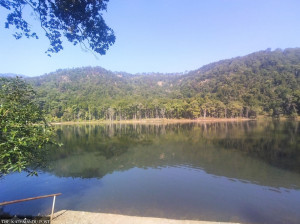Sudurpaschim Province
Buffer zone residents in Kanchanpur accused of deliberately killing Sal trees
Forest officials say locals peel the bark off and harm the roots to kill the trees and are also involved in timber smuggling.
Bhawani Bhatta
The once abundant Sal (Shorea robusta) trees in the Chandev village of Laljhadi Rural Municipality-6 are dead and rotting. The village is close to the buffer zones of the Hariya Community Forest and Baijnath Community Forest of the Shuklaphanta National Park.
But the Sal trees are not dying due to natural causes, the locals have taken to peeling the bark off the Sal trees to kill the trees in order to encroach the forest area for their settlement, allege community forest officials.
Meena Chaudhary, president of Shobhatal Buffer Zone Community Forest, which manages the other community forests in the buffer zones, and chairperson of the buffer zone community forests committee, said that the trees and saplings were green until a few years ago in all of the community forest areas. “But now the locals are killing the trees using various ways such as harming their roots, peeling off the bark of the whole tree or simply peeling the barks off the base of the tree,” she said. “The locals have deliberately killed trees bordering their fields and the forests and have also been doing the same inside the forest areas.”
Trees are withering in the area but paddy fields are still lush.
According to Chaudhary, what is surprising to her is that the dead trees disappear overnight. “The locals are also engaged in smuggling timber,” she added.
The locals first remove the bark, then slowly cut the roots and wait for the tree to die. “Locals have been doing this to expand their settlement into the Hariya Buffer Zone Forest which covers an area of 159 hectares. The settlements around the forest area are growing and the residents of these settlements are trying to encroach the forest area,” said Chaudhary.
The locals deny the allegations.
Arjun Bohara, a local of Chandev, says that the locals are not engaged in killing trees and that the trees might have died due to natural causes. “Some young trees may have died after the locals removed the bark not knowing what happens to trees when you do so,” he said.
According to the Shuklaphanta National Park, the Chandev region is also a traditional route for elephants from the Shuklaphanta National Park to the Laljhadi-Mohana wildlife corridor. Elephants reach Shuklaphanta National Park from India's Dudhuwa National Park through the Laljhadi-Mohana Wildlife Corridor. Those elephants go from Shuklaphanta to Pilibhit Tiger Reserve in India and return the same way.
Trees are dying not only in the park area but also in other forests, says Manoj Air, Assistant Conservation Officer of the National Park.
“If deforestation continues at this pace then elephants will lose their natural pathway,” said Air. “If there is human population growth in the area then the chances of human-wildlife conflict will also increase. Trees provide protection to the animals that live in the forest and those that migrate.” According to him, elephants have already terrorised locals in the Chandev region for the past few years, destroying crops and damaging property. “The forest area is shrinking because of encroachment. If this is not stopped right away, human-animal conflicts will become a regular occurrence.”




 11.12°C Kathmandu
11.12°C Kathmandu











%20(1).jpg&w=300&height=200)

